View in other NatureServe Network Field Guides
NatureServe
Montana
Utah
Wyoming
Idaho
Wisconsin
British Columbia
South Carolina
Yukon
California
New York
Hollyleaf Clover - Trifolium gymnocarpon
State Rank Reason (see State Rank above)
Known from many sites within the West Fork Bitterroot River drainage, which would encompass one large metapopulation. Also known in Montana from one disjunct occurrence in the Rock Creek drainage on the Lolo National Forest. Invasive weeds, particularly spotted knapweed, are a problem in some of the habitat occupied by the species. However, Trifolium gymmocarpon, as with other clover species, appears capable of tolerating or even benefitting from some disturbance.
General Description
Hollyleaf Clover forms clumps with many stems that are ca. 15 cm high and arising from a branched rootcrown and a stout taproot. The leaves arise from the base of the stems and have membranous appendages that are 5-15 mm long at the base and which remain as shreds on the rootcrown. Each leaf has three ovate leaflets that are 5-20 mm long with sharply toothed margins. The herbage is sparsely covered with straight, appressed hairs. Three to 15 spreading to nodding flowers are borne in loose clusters at the ends of peduncles, which are usually shorter than the leaves. The light yellow to flesh-colored flowers are 8-14 mm long and have a hood-shaped upper petal, or banner, and two narrow, separate petals on the side (wings); the two lower petals are united into a boat-shaped petal, or keel. The densely long-hairy calyx is 1/3 to 1/2 as long as the corolla and is tubular at the base but forms 5 long, triangular teeth at the mouth. The small fruit pod usually has a single seed.
Phenology
Flowering in May-July.
Diagnostic Characteristics
This is our only tufted clover without leafy stems that occurs below the subalpine zone.
Species Range
Montana Range
Range Descriptions
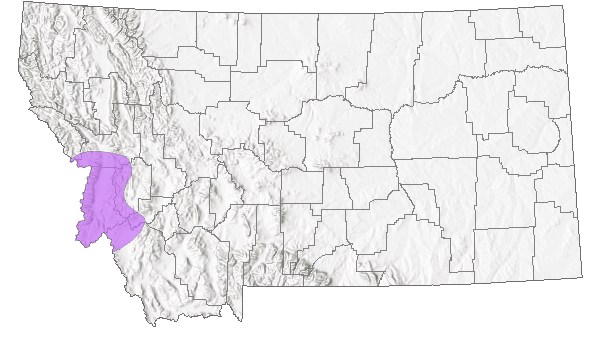
 Native
Native
Range Comments
Northeast OR to northeast CA and northern AZ, east to MT and NM. Peripheral.
Observations in Montana Natural Heritage Program Database
Number of Observations: 108
(Click on the following maps and charts to see full sized version)
Map Help and Descriptions
Relative Density
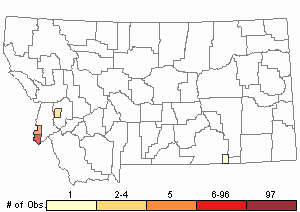
Recency
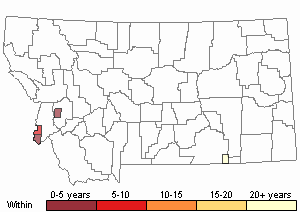
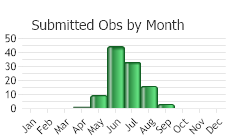
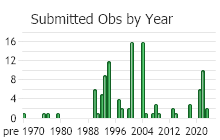
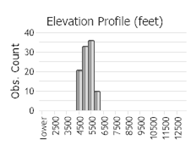 (Observations spanning multiple months or years are excluded from time charts)
(Observations spanning multiple months or years are excluded from time charts)
Habitat
Open woods and slopes, usually in dry soil of sagebrush steppe to ponderosa pine forest in the foothills to lower montane zone.
Ecological Systems Associated with this Species
Ecology
POLLINATORS The following animal species have been reported as pollinators of this plant species or its genus where their geographic ranges overlap:
Bombus vagans,
Bombus appositus,
Bombus auricomus,
Bombus bifarius,
Bombus borealis,
Bombus centralis,
Bombus fervidus,
Bombus flavifrons,
Bombus frigidus,
Bombus huntii,
Bombus melanopygus,
Bombus mixtus,
Bombus nevadensis,
Bombus rufocinctus,
Bombus sylvicola,
Bombus ternarius,
Bombus occidentalis,
Bombus pensylvanicus,
Bombus bimaculatus,
Bombus griseocollis,
Bombus impatiens,
Bombus insularis,
Bombus suckleyi,
Bombus bohemicus,
Bombus flavidus, and
Bombus kirbiellus (Plath 1934, Hobbs 1966, Macior 1974, Heinrich 1976, Bauer 1983, Thorp et al. 1983, Mayer et al. 2000, Rao and Stephen 2007, Wilson et al. 2010, Colla and Dumesh 2010, Colla et al. 2011, Koch and Strange 2012, Koch et al. 2012, Miller-Struttmann and Galen 2014, Williams et al. 2014).
Stewardship Responsibility
Threats or Limiting Factors
STATE THREAT SCORE REASON
Reported threats to Montana's populations of Hollyleaf Clover include impacts due to noxious weeds, and potential impacts from firewood gathering and recreation activity (MTNHP Threat Assessment 2021). Spotted Knapweed (Centaurea stoebe) occurs with low density at some populations with slight negative impacts. Noxious weed populations have potential to expand with greater negative impacts following ground disturbances that expose bare soil, such as firewood gathering and recreation activity. Information about the scope, severity, and timing of impacts from firewood gathering and/or recreational activities is needed to assess their contribution to impacts.
References
- Literature Cited AboveLegend:
 View Online Publication
View Online Publication Bauer, P.J. 1983. Bumblebee pollination relationships on the Beartooth Plateau tundra of Southern Montana. American Journal of Botany. 70(1): 134-144.
Bauer, P.J. 1983. Bumblebee pollination relationships on the Beartooth Plateau tundra of Southern Montana. American Journal of Botany. 70(1): 134-144. Colla, S., L. Richardson, and P. Williams. 2011. Bumble bees of the eastern United States. Washington, DC: USDA Forest Service, Pollinator Partnership. 103 p.
Colla, S., L. Richardson, and P. Williams. 2011. Bumble bees of the eastern United States. Washington, DC: USDA Forest Service, Pollinator Partnership. 103 p. Colla, S.R. and S. Dumesh. 2010. The bumble bees of southern Ontario: notes on natural history and distribution. Journal of the Entomological Society of Ontario 141:39-68.
Colla, S.R. and S. Dumesh. 2010. The bumble bees of southern Ontario: notes on natural history and distribution. Journal of the Entomological Society of Ontario 141:39-68. Hobbs, G.A. 1966b. Ecology of species of Bombus Latr. (Hymenoptera: Apidae) in southern Alberta. V. Subgenus Subterraneobombus Vogt. Canadian Entomologist 98: 288-294.
Hobbs, G.A. 1966b. Ecology of species of Bombus Latr. (Hymenoptera: Apidae) in southern Alberta. V. Subgenus Subterraneobombus Vogt. Canadian Entomologist 98: 288-294. Koch, J., J. Strange, and P. Williams. 2012. Bumble bees of the western United States. Washington, DC: USDA Forest Service, Pollinator Partnership. 143 p.
Koch, J., J. Strange, and P. Williams. 2012. Bumble bees of the western United States. Washington, DC: USDA Forest Service, Pollinator Partnership. 143 p. Koch, J.B. and J.P. Strange. 2012. The status of Bombus occidentalis and B. moderatus in Alaska with special focus on Nosema bombi incidence. Northwest Science 86:212-220.
Koch, J.B. and J.P. Strange. 2012. The status of Bombus occidentalis and B. moderatus in Alaska with special focus on Nosema bombi incidence. Northwest Science 86:212-220. Macior, L.M. 1974. Pollination ecology of the Front Range of the Colorado Rocky Mountains. Melanderia 15: 1-59.
Macior, L.M. 1974. Pollination ecology of the Front Range of the Colorado Rocky Mountains. Melanderia 15: 1-59. Mayer, D.F., E.R. Miliczky, B.F. Finnigan, and C.A. Johnson. 2000. The bee fauna (Hymenoptera: Apoidea) of southeastern Washington. Journal of the Entomological Society of British Columbia 97: 25-31.
Mayer, D.F., E.R. Miliczky, B.F. Finnigan, and C.A. Johnson. 2000. The bee fauna (Hymenoptera: Apoidea) of southeastern Washington. Journal of the Entomological Society of British Columbia 97: 25-31. Miller-Struttmann, N.E. and C. Galen. 2014. High-altitude multi-taskers: bumble bee food plant use broadens along an altitudinal productivity gradient. Oecologia 176:1033-1045.
Miller-Struttmann, N.E. and C. Galen. 2014. High-altitude multi-taskers: bumble bee food plant use broadens along an altitudinal productivity gradient. Oecologia 176:1033-1045. MTNHP Threat Assessment. 2021. State Threat Score Assignment and Assessment of Reported Threats from 2006 to 2021 for State-listed Vascular Plants. Botany Program, Montana Natural Heritage Program, Helena, Montana.
MTNHP Threat Assessment. 2021. State Threat Score Assignment and Assessment of Reported Threats from 2006 to 2021 for State-listed Vascular Plants. Botany Program, Montana Natural Heritage Program, Helena, Montana. Plath, O.E. 1934. Bumblebees and their ways. New York, NY: Macmillan Company. 201 p.
Plath, O.E. 1934. Bumblebees and their ways. New York, NY: Macmillan Company. 201 p. Rao, S. and W.P. Stephen. 2007. Bombus (Bombus) occidentalis (Hymenoptera: Apidae): In decline or recovery. Pan-Pacific Entomoligist 83(4): 360-362.
Rao, S. and W.P. Stephen. 2007. Bombus (Bombus) occidentalis (Hymenoptera: Apidae): In decline or recovery. Pan-Pacific Entomoligist 83(4): 360-362. Thorp, R.W., D.S. Horning, and L.L. Dunning. 1983. Bumble bees and cuckoo bumble bees of California (Hymenoptera: Apidae). Bulletin of the California Insect Survey 23:1-79.
Thorp, R.W., D.S. Horning, and L.L. Dunning. 1983. Bumble bees and cuckoo bumble bees of California (Hymenoptera: Apidae). Bulletin of the California Insect Survey 23:1-79. Williams, P., R. Thorp, L. Richardson, and S. Colla. 2014. Bumble Bees of North America. Princeton, NJ: Princeton University Press. 208 p.
Williams, P., R. Thorp, L. Richardson, and S. Colla. 2014. Bumble Bees of North America. Princeton, NJ: Princeton University Press. 208 p. Wilson, J.S., L.E. Wilson, L.D. Loftis, and T. Griswold. 2010. The montane bee fauna of north central Washington, USA, with floral associations. Western North American Naturalist 70(2): 198-207.
Wilson, J.S., L.E. Wilson, L.D. Loftis, and T. Griswold. 2010. The montane bee fauna of north central Washington, USA, with floral associations. Western North American Naturalist 70(2): 198-207.
- Additional ReferencesLegend:
 View Online Publication
View Online Publication
Do you know of a citation we're missing? Lesica, P., M.T. Lavin, and P.F. Stickney. 2012. Manual of Montana Vascular Plants. Fort Worth, TX: BRIT Press. viii + 771 p.
Lesica, P., M.T. Lavin, and P.F. Stickney. 2012. Manual of Montana Vascular Plants. Fort Worth, TX: BRIT Press. viii + 771 p. Lesica, P., M.T. Lavin, and P.F. Stickney. 2022. Manual of Montana Vascular Plants, Second Edition. Fort Worth, TX: BRIT Press. viii + 779 p.
Lesica, P., M.T. Lavin, and P.F. Stickney. 2022. Manual of Montana Vascular Plants, Second Edition. Fort Worth, TX: BRIT Press. viii + 779 p.
- Web Search Engines for Articles on "Hollyleaf Clover"





